|
PZL
P.37 Łoś (Elk)
by Lukasz Kedzierski
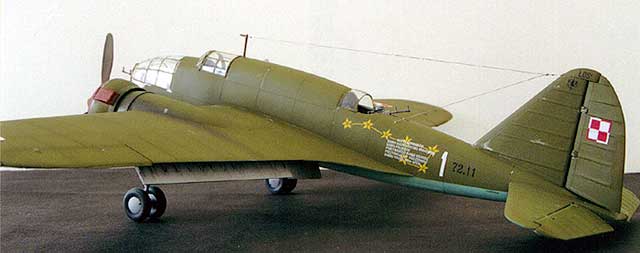 |
|
PZL
P.37 Łoś |

Mirage's 1/48
scale PZL P.37A is available online from Squadron.com
PZL P.37 (Panstwowe
Zaklady Lotnicze - National Aviation Establishment) was the most modern aircraft
in the inventory of the Polish Air Force in September 1939 and a symbol of
Polish technological ingenuity. In fact it was one of the best medium bombers of
its time featuring several advanced technological designs, combining good
performance and manoeuvrability with high bomb carrying capability. However, too
few aircraft were delivered to the front line units by the time WW2 broke out to
make a considerable contribution to the Polish war effort in September 1939.
This was due to design’s “teething” problems and equipment delivery delays.
Development
The PZL P.37 was
developed in response to the specifications issued by the Departament
Aeronautyki (Department of Aeronautics) in 1934 for a new twin engine bomber
capable of carrying a bombload of 2000 kg (including 300 kg bombs) with speed in
excess of 350 km/h and a range of 1200 km. The task of designing a new aircraft
was given to a team of engineers led by Jerzy Dabrowski and Piotr Kubicki.
The new design was aerodynamically “clean” with a fuselage of small elliptical
cross-section that enabled the plane to reach speed of 400 km/h, this however,
necessitated the inclusion of bomb bays in the wings. To accommodate the bomb
bays Dabrowski designed a new wing profile of very good aerodynamic
characteristics that was similar to the first laminar profiles, which become
widely used in military aircraft later during the war. The wing also featured a
caisson patented by dr. Misztal and successfully used in Polish challenge
aircraft PZL.19 and PZL.26. Departament Aeronautyki accepted Dabrowski’s project
with a few minor modifications such as reduction of aircraft’s defensive
armament in favour of achieving higher speed.
Prototypes
The construction of
prototypes commenced in 1935 and in the same year PZL received and order for 10
production PZL P.37A’s soon increased to 30 aircraft. The first prototype
(PZL.37/I, no. 72.1; 72 being military designation of the type) was powered by
Bristol Pegasus XIIB and test flown in 1936 revealing several problems with fuel
system, main undercarriage shock absorbents, rudder etc. These were fixed by PZL
and in 1937 the aircraft was transferred to ITL (Aviation Technology Institute)
for further testing. The second prototype (P.37/II, 72.2) was completed in 1937.
The aircraft was powered by Bristol Pegasus XX engines, had redesigned cockpit
and twin vertical stabilizers in place of a single one to improve the rear field
of fire. Revolutionary unit with sway beam and twin wheels replaced heavy main
undercarriage unit with a single wheel. A new undercarriage was designed and
patented by Piotr Kubicki.
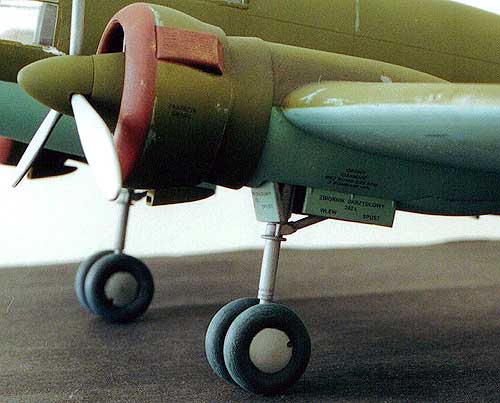
In 1938 both
prototypes were tested in ITL. During those tests P.37/I was lost due to
inadequate riveting of the main wing that caused the wing to break off during
flight. Production started in 1938 with 10 P.37A's (single vertical tailplane)
being completed first, followed by 20 P.37Abis (twin tailplane). Two aircraft of
the latter batch were converted to demonstrator aircraft with the civil
registrations SP-BNK and SP-BNL. SP-BNK was used to test Gnome-Rhone (GR) 14N
engines and became a prototype for the export variant P.37C (P.37/III). Łoś C
was demonstrated in Greece and Turkey where it crash-landed due to poor weather
conditions. The aircraft was left in Turkey, while the crew went back to Poland.
SP-BNL was used in a promotional flight to Romania, Bulgaria, Greece and
Yugoslavia where it was shown in Belgrade during the International Aviation Show
in 1938. During the same year this aircraft was shown in Paris and in the
meantime a flight of 2 Łoś A’s and 1 Łoś Abis was demonstrated in Bulgaria. Łoś
was very well received by the international aviation experts and was considered
to be one of the best bombers at the time due to its high speed and great
bombload.
In 1938 PZL started a licence production of Bristol Pegasus engines designated
PZL Pegaz XXA and B, and initiated production of PZL P.37B of which 124 aircraft
were ordered by the Polish Air Force. By the end of 1938 PZL completed 50 Łoś
B’s, the remaining production was postponed due to a series of unexplained
crashes, shifting resources to the production line of PZL P.43 (export version
of PZL P.23 Karas) and initiation of production of a new fighter, PZL P.50. In
early 1939 the production was halted altogether due to the change of Air Force
Commander-in-Chief, who put more emphasis on the development of fighter planes.
Total of 104 airframes was completed and production of the additional 20 was
moved to a new PZL factory in Mielec of which only a few were completed before
the hostilities of September 1939 broke out.
If not for the war Łoś could have been a huge PZL export success. PZL planned
production of export variants P.37C with GR 14NO1 engines and P.37D with GR
14N21 engines, which were offered to several European countries. Belgian
goverment purchased the rights to a licence production of Łoś, whereas Greece
ordered 12 aircraft with the possibility to expand the order to 24. Bulgaria
displayed interest in acquiring 15 P.37C’s, Yugoslavia 20, Romania was
interested in a procurement of 30 P.37D’s as well as a licence production,
Turkey was interested in a purchase of 10 P.37D’s with additional 25 aircraft to
be assembled in Turkey from parts delivered by Poland. Other countries
interested in Łoś included Denmark, Estonia and Finland. The Spanish Republican
government placed a clandestine order for 50 Łoś C’s, but the Republicans were
defeated before the deliveries could commence. If all of the above orders were
finalised, it would have kept Łoś on the production lines well until 1940.
In Service
The First P.37s (mainly A and Abis) were delivered to
operational units in late 1938 and equipped 210 Dywizjon Bombowy (bomber
squadron) consisting of 211 and 212 Eskadra, and 220 Dywizjon Bombowy (221 and
222 Eskadra) of the 1st Pulk Lotniczy (Aviation Regiment). Each eskadra
consisted of 9 aircraft, however, deliveries were very slow due to delays in
deliveries of radio equipment, guns, bomb racks and propellers.
210 Dywizjon reached combat readiness in March 1939 and at
the same time 215 Dywizjon Bombowy was being formed consisting of 216 and 217
Eskadra. By April 60 P.37s were delivered and in June there was 36 Łoś in the
first line units and 38 in reserve. By the end of August 1939 the Polish Army
was put on alert since war seemed inevitable. Łoś equipped units formed part of
the Brygada Bombowa (Bomber Brigade) along with units using obsolete PZL P.23
Karas.
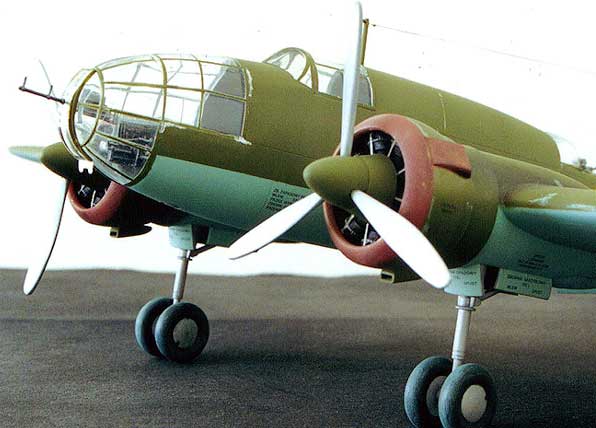
On 31 August 1939 the Air Force had a total of 86 PZL
P.37s: 36 in X and XV (ex-210 and 215) Dywizjon as part of Brygada Bombowa, 31
in Malaszewice Base (20 in XX reserve (ex-220) Dywizjon plus additional 11 from
various training units), 5 in Samodzielny Dyon Doswiadczalny (experimental unit)
and 14 undergoing repairs mainly in PZL Okecie factory. Additional 31 airframes
were at different stages of assembly in Okecie and Mielec.
At War
Enemy air superiority, dispersal of Polish bomber units and
inadequately equipped field airstrips prevented the effective use of Poland’s
most modern aircraft in the September Campaign. Łoś was mainly used for missions
that included reconnaissance and bombardment of German mobile forces, a task for
which Łoś was not intended. Moreover, none of the sorties included a large
number of aircraft that could inflict any considerable damage.
Repairs of damaged aircraft were not possible since the
ground crews did not have all the essential equipment and battle worthiness was
further affected by the fact that most of the aircraft were not fully equipped
(radio, compass, etc.). Shortage of fuel and inability to coordinate operations
with Polish fighters (it should be noted that PZL P.37 was much faster than any
of the contemporary Polish fighters) deteriorated the situation even more.
P.37’s of Brygada Bombowa made a total 135 sorties (from 1.09 to 19.09.1939) of
which 25 were purely reconnaissance. Most of the bombing missions involved
attacks on randomly chosen mobile German forces and a total of 119 tonnes of
bombs were dropped.
27 aircraft were lost which accounts for 75% of the initial
strength (59% including reinforcements delivered during the hostilities): 11
were destroyed by enemy fighters, 5 by enemy AA fire, 1 by friendly AA fire, 2
were destroyed on the ground by enemy bombers, 3 were abandoned by crews due to
technical difficulties, 3 were damaged on the ground and lost due to the pilot
error, 2 crash landed due to the lack of fuel.
German forces captured a total of 41 P.37s in Warsaw and Mielec. Those aircraft
were at different stages of assembly although several were completed. Polish
workers used by Germans to clear airfields destroyed the majority of them, which
resulted in only two PZL P.37B’s being airworthy. Both aircraft received German
markings and one was sent to Rechlin for testing where it crashed. The second
aircraft was a part of the “Victory in the West” exposition that took part in
Vienna in 1940. Its final fate is unknown.
The German war booty also included 50 brand new PZL Pegasus
XX engines that were sold to Sweden and used in Ju-86K-13.
Polish crews evacuated 27 P.37s to Romania. These aircraft
were ceased by the Romanian government and despite Polish government's
diplomatic efforts backed up by France and Great Britain the aircraft were never
returned to Polish Air Force, which new squadrons were being formed in France.
Later on the aircraft equipped 76 and 77 Squadron of Fortele Aeriene Regale
Romane (Royal Romanian Air Force) and took part in the attack on Soviet Union in
1941.
By the end of 1941 Łoś was used for training of Ju 88 crews
and remained in this role until 1944.
-
Powerplant:
two 680 kW PZL Pegaz XX engines
-
Crew:
4
-
Wingspan:
17.93 m
-
Length:
12.92 m
-
Height:
4.25 m
-
Weight:
empty 4935 kg, max loaded 8880 kg
-
Max
speed: 412 km/h at 2800 m
-
Service
ceiling: 5900 m
-
Range:
max. 1750 km
-
Armament:
three 7.92 mm either Vickers F or PWU wz.37 machine guns and up to 2595 kg of
bombs
Comparison
between PZL P.37B Łoś and other pre-war medium bombers:
|
type |
powerplant
(kW) |
wingspan (m) |
length (m) |
weight (kg) |
armament |
bombload (kg) |
max speed |
range (km) |
service
ceiling |
|
PZL P37B |
2 x 680
|
17.93 |
12.92 |
4935 |
3 x 7.9 mm |
2595 |
412 km/h |
1750 |
5900 m |
|
He-111P-2 |
2 x 810
|
22.5 |
16.4 |
6380 |
3 x 7.9 mm |
2000 |
410 km/h |
1500 |
8000 m |
|
Do-17M-1 |
2 x 662 |
18.0 |
16.25 |
5610 |
4 x 7.9 mm |
1000 |
365 km/h |
1375 |
6700 m |
|
Blenheim Mk.
I |
2 x 618 |
17.17 |
12.11 |
3674 |
2 x 7.7 mm |
454 |
418 km/h |
1810 |
8315 m |
|
Wellington
Mk. IC |
2 x 736 |
26.26 |
19.68 |
8417 |
6 x 7.7 mm |
2041 |
378 km/h |
4104 |
5486 m |
|
Fiat BR-20M |
2 x 736 |
21.56 |
16.68 |
6500 |
3 x 12.7 mm |
1600 |
440 km/h |
2750 |
8000 m |
|
SM.79
|
3 x 735 |
21.32 |
16.25 |
7610 |
2 x 12.7mm
3 x 7.7 mm |
1200 |
433 km/h |
2000 |
7000 m |
|
SB-2 |
2 x 632 |
20.33 |
12.27 |
4138 |
4 x 7.62 mm |
1000 |
423 km/h |
2150 |
9560 m |
|
Ki-21-II b |
2 x 1104 |
22.5 |
16.0 |
6070 |
1 x 12.7 mm
4 x 7.7 mm |
1000 |
486 km/h |
2700 |
10000 m |
|
The PZL P.37 in 1/48
Scale |
For modellers in Poland, the Łoś is an essential part of a
collection. As far as I know all my friends had a model of Łoś so it is a pretty
common thing, but for many of you it is an esoteric subject. For me, Łoś started
my modelling passion (otherwise described by my wife as a mental disorder and
obsession that's out of control) since it was the first model kit that I put
together. It was Mikro's 1:144 scale PZL P.37B.
A few years later ZST Plastyk released their 1:72 offering that has been
re-boxed by numerous companies in Poland and it's the only one model kit of this
aircraft in 1:72 scale. PART has produced two photo-etched sets that improve the
model considerably and Engines 'n' Things makes Pegasus engines for Los.
However, everyone was longing for 1:48 scale kit. S-Model released in the mid
90's a vacuformed kit in this scale enhanced with resin parts (see construction
feature elsewhere on HyperScale), but it was too expensive for many modellers
and not really suitable for vac-illiterates (I have this kit and its resin parts
will come handy soon).
Finally Mirage Hobby, a company that makes quite a lot of
kits of Polish aircraft, armour and ships, released two different kits of Los in
1:48 scale - single tail P.37A and twin tail P.37B. As you can imagine I got
both of them straight away as well as resin Bristol Pegasus engines and PART
photo-etched sets (3 altogether dealing with interior and exterior details and
offering replacement flaps) that were releases almost simultaneously with the
Mirage Hobby kit. However, this article deals with the out-of-box construction
of PZL P.37A, which will be hopefully soon followed by another build feature of
PZL P.37B stuffed with metal and resin.
The Mirage Kit In
The Box
What you get in the box is 5 sprues of parts moulded in
dark grey plastic with recessed panel lines, one sprue of transparent parts
(nice and clear, but a bit thick) and an excellent decal sheet printed by
Techmod.
Major parts have a slightly grainy surface and a few sink marks, and my example
had a hole in the lower wing next to the engine. Smaller parts are a bit
simplified, but acceptable. Cockpit interior is pretty well detailed with switch
and radio boxes, oxygen bottles, emergency flares and ammunition drums for
machine guns (both types, Vickers and PWU are included). Unfortunately, the
instrument panel is very oversimplified (holes in the panel) and ventral gunner
position is moulded in closed position, which is correct since it was usually
closed on the ground, but it would be nice to leave it up to the modeller.
Flaps can be depicted either closed or deployed and wing
bomb bays can be shown open with 18 100kg bombs inside. A fuselage bomb bay is
not provided, which is a pity since it was the only one that could carry 300kg
bombs or additional fuel tanks, and I suppose they all were opened
simultaneously.
There are also optional spinners, main undercarriage legs and wheels with
different hubs, but this is applicable to B variant not A. The engines are
probably the biggest let down of this kit, but once installed and painted not
much can be seen anyway.
Instructions are clear and comprehensive (entirely in
Polish). There is the type history and specifications, tips and hints for
modellers (AM style), 20 construction diagrams as well as painting and decal
placement guide. There is an additional sheet with colour profiles for all decal
options and colours are given as Humbrol numbers.
As usual, I started with a cockpit and after
painting, drybrushing etc, was quite happy with the final result. I know I said
that the instructions are clear, however, the placement of different
subassemblies in the cockpit is sometimes vague and reference photos are needed.
Both fuselage halves went together without
problems, but be aware there are no locating pins. Some of the panel lines did
not actually joined whereas others did and I suppose that is manufacturing
fault, but it was easily corrected. The ventral gunner position needs some
attention as well namely getting it into shape (the frame has different width on
both fuselage halves). Tailplane assembly did not caused any problems, but I
sanded down the strips covering riveting since they were too pronounced.
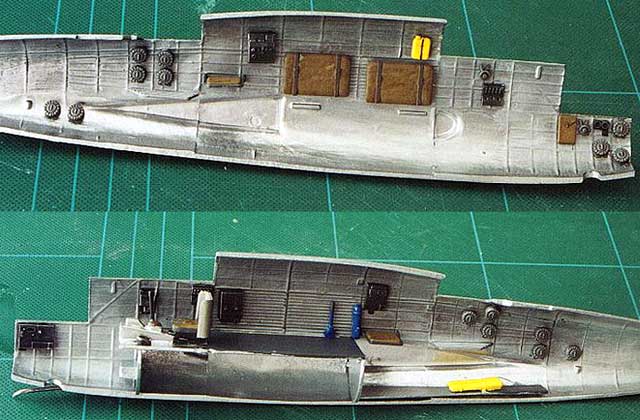
Wings were next and these require some work. I decided to
depict flaps in a deployed position and have the bomb bays open. The assembly of
18 bombs was a real pain and their fins are better replaced with scratchbuilt
ones from plasticard. Do not follow instructions here and install bombs after
completion of painting otherwise you will keep loosing them while dealing with
the wing-fuselage joint (I learnt it the hard way).
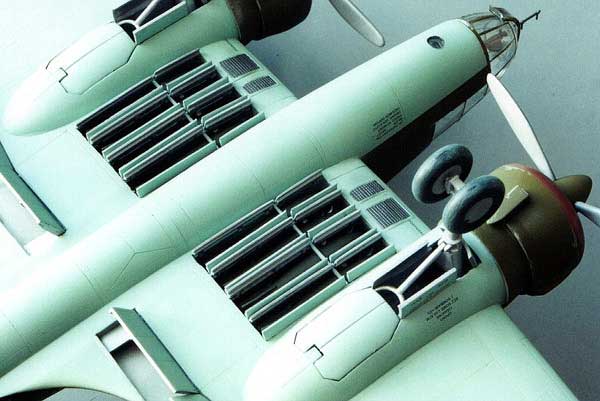
The flaps opening has a conspicuous "step" on the inside
surface of upper wing that needs to be sanded if you want to have the flaps in a
dropped position. The radiator imitations on the wings look ridiculous and need
replacement, but they are included in one of PART PE sets.
With wings, fuselage and tail section all done it was time
to put them together. They do not fit very well and all joints require some
filling, filing and sanding, but I have done it all before so there was no
surprise here. Engines' and propellers' assemblies did not pose any problems
neither did undercarriage.
Next I turned my attention to glazing. The windscreen comes
together with a section of upper fuselage, which caused a bit of a problem since
the fuselage sides were springing apart and some persuasion with clamps, rubber
bands and superglue was needed. The cockpit and dorsal gunner canopies fit
nicely, but they a bit on a thick side of things and this may be a problem when
you want to show them in open position. The nose glazing comes in two halves
split vertically along the frames so caution needs to be exercised when sanding
down the joint. And that pretty much concludes the construction.
Painting time!! Well, not much variety here
since all pre-war Polish aircraft were painted Polish khaki upper surfaces,
light blue-grey lower surfaces. And that's what you get in here - three marking
options sporting identical camouflage. Two of them are Polish - P.37A white 1
(72.11) of 212 Eskadra Bombowa in 1938 and white 3 (72.5) of the same unit in
1939. Apart from squadron numbers and serial numbers (only on the left side of
the fuselage) these aircraft are also wearing the PZL logo on the tail and
Polish national insignia on the wings and rudder. Polish checkers on the upper
wings were positioned asymmetrically in relation to the fuselage, which was
supposed to make aiming by an attacking fighter more difficult. Both aircraft
also sport the unit logo - Ursa Major (Great Bear, a constellation on the
Northern Hemisphere sky), white 1 has also a foundation inscription on the
fuselage, this particular aircraft was purchased from money donated by Polish
banks. The last option is a sole P.37A in Romanian service that belonged to 76
Squadron (1941). This aircraft wears the Polish camouflage, but has a yellow
fuselage band, Romanian crosses in six positions and white 201 number on the
tail.
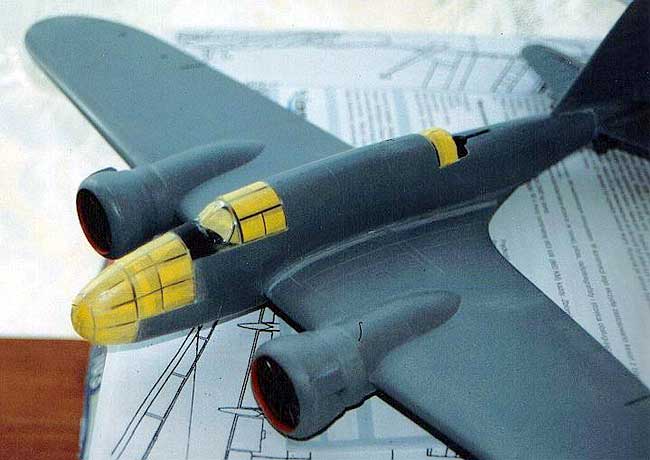
Mirage Hobby gives you Humbrol paint colours,
which is fine with the exception that some of them are no longer in production
like the elusive Polish khaki - Humbrol 142. I have never seen this colour and
cannot buy it here in Australia (my friends told me it is still available in
some hobby shops in Poland) and everyone has a different idea as to its shade
ranging from dark green to khaki. I am no expert in this area, but I tried khaki
before (Tamiya XF-49) and that does not look right, I also used MM equivalent of
H142 that is called Field Drab and this one does not look right either, and I
have seen green but that seems to be too dark. So I mixed my own brew of Polish
khaki form Humbrol 150 Forest Green with some scarlet, yellow and green. Looks
good to me.
Undersides are quoted as light blue (H65) and
that's what I used, but I think it's wrong. The colour should be more greyish
and I was told that H147 or lightened H87 are the correct colours. Everything
else is easy - Towsend ring and exhausts were painted H113 drybrushed with some
silver and copper, propeller blades and undercarriage are aluminium. Weathering
was accomplished by spraying with lightened main camouflage colours and Tamiya
smoke as well as minimal paint chipping. It has to be remembered that these
aircraft were in service for about a year so do not go overboard here.
The entire kit was sealed with Super Shine and
decals applied. Decals are printed by Techmod and are of outstanding quality.
Perfect register, colour density and thickness with minimal carrier film (that
applies to my Łoś A, in Łoś B decals are out of register).
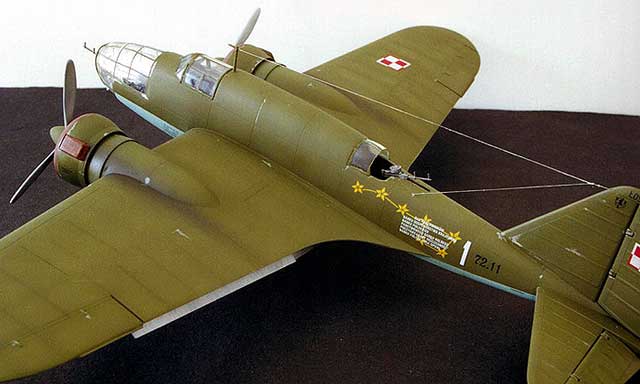
You get two full sets of national insignia (both Polish and
Romanian), stencils and all the other markings. I used Aero Set and Sol on my
decals and there was no adverse effects and no silvering at all. Fantastic!! The
entire model was then sealed with H135 varnish and final details were installed
such as antenna, guns and all the bombs that fell out from bomb bays.
What's an outstanding kit!
Do not expect Tamigawa-Revelloogram quality but it is
definitely a good kit with just a few small faults. Decals are fantastic, there
is plenty of potential for improvement and it builds into a pretty big model of
a very interesting aircraft. And believe me you can even win competitions with
this kit built out-of-box (I did).
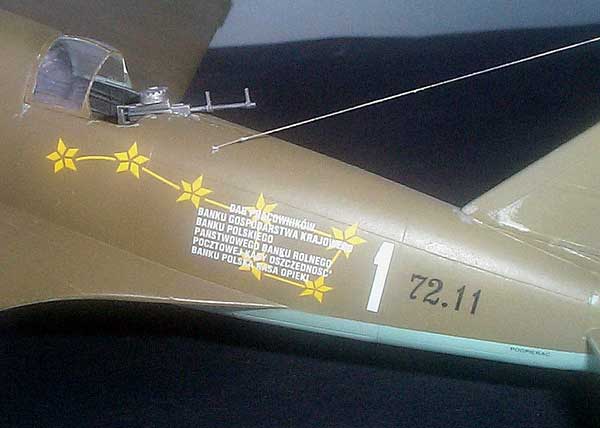
My next Łoś will involve PART's photo-etched sets and
S-Model resin combined with Engines'n'Things powerplants.
In contrary to the common believe that there are no
references to PZL P.37 (expressed on Internet Modeler, Hyperscale discussion
group or some hobby magazines) I have to assure you there is plenty. The only
problem is that they are all in Polish, have been published some time ago and
are not easily available at the moment.
I can highly recommend two of them: Samolot bombowy PZL
P-37 Łoś (Bomber aircraft PZL P-37 Los) by Jerzy Cynk (an authority when it
comes to Polish aviation) published in 1990 and Samoloty bombowe wrzesnia 1939
(Bombers of September 1939) by Andrzej Glass et al. (another expert in Polish
aviation) published in 1991 (see attached pic).
The former is a comprehensive monograph dealing with the
history of Polish bomber aviation, history of development of Los, technical
description and day by day account of combat use of PZL P.37s in 1939.
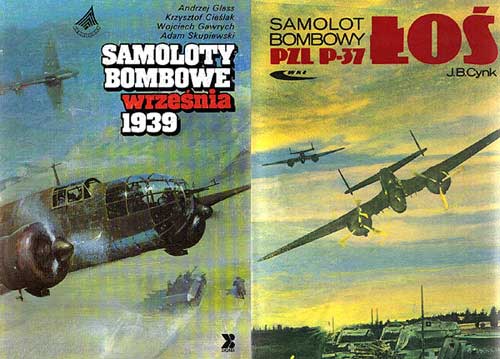
The latter has been written with modellers in mind and contains
a brief introduction about pre-war use of bombers in different countries with
emphasis on Poland and Germany and in subsequent chapters deals with bombers of
Polish Campaign of 1939 (development, technical descriptions etc.): PZL P.37
LWS-4, Do-17, He-111, Ju-86 and Ju-52. There are 3 fairly brief sections
describing the use of bombers by Poland, Germany and Soviet Union (just half a
page). The last section is a real gem since it is a reprint of the original user
manual for PZL P.37 from 1938 with good photos of the cockpit etc. (I wish they
were printed on better quality paper). There is also a full set of scale plans,
cutaway diagrams and colour profiles for all the aircraft mentioned.
Another useful book is Polskie konstrukcje lotnicze 1893-1939
(Polish aircraft designs 1893-1939) by Andrzej Glass published in 1976. This one
deals with every single aircraft, glider and engine built in Poland during this
period.
There is also a series of articles and colour profiles published
over the years in Skrzydlata Polska (Winged Poland) magazine and more recently
Mini Replika published a set of scale plans with corrected positions of various
panel lines.
And I bet that two recently published books (in English this
time), White Eagles and Polish Air Force 1939-1945 have some good photos and
colour profiles of Los. Unfortunately I do not have either of them at present.
Click the thumbnails below to view
larger images:
Model, Images and
Article Copyright © 2002 by
Lukasz Kedzierski
Page Created 11 January, 2002
Last updated 11 January, 2002
Back to HyperScale Main Page
Back to Features Page |
Home |
What's New |
Features |
Gallery |
Reviews |
Reference |
Forum |
Search